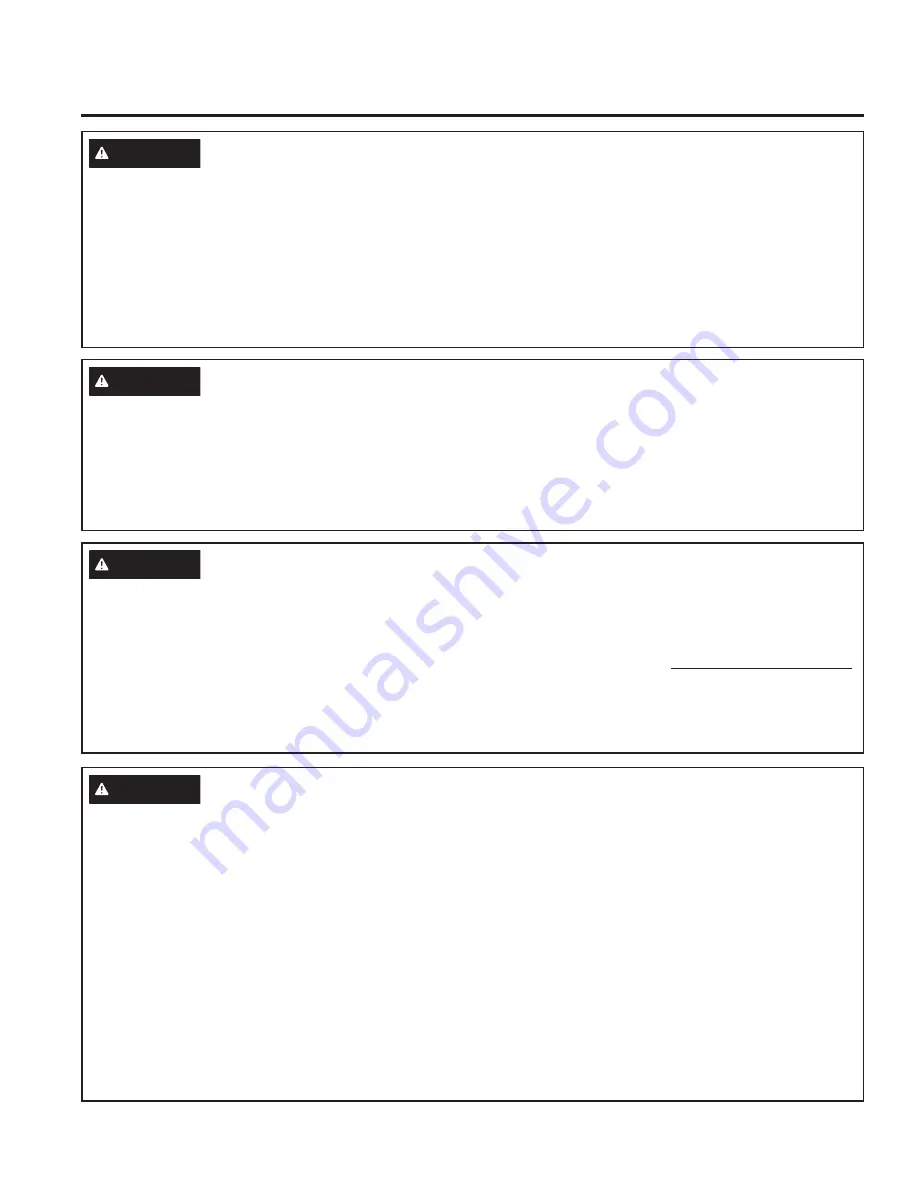
4
49-2000723 Rev. 0
WARNING
KEEP FLAMMABLE MATERIALS AWAY FROM THE RANGE
Failure to do so may result in fire or personal injury.
■ Do not store or use flammable materials in an oven
or near the cooktop, including paper, plastic, pot
holders, linens, wall coverings, curtains, drapes and
gasoline or other flammable vapors and liquids.
■ Never wear loose-fitting or hanging garments while
using the appliance. These garments may ignite if
they contact hot surfaces causing severe burns.
■ Do not let cooking grease or other flammable
materials accumulate in or near the range. Grease in
the oven or on the cooktop may ignite.
■ Clean ventilating hoods frequently. Grease should
not be allowed to accumulate on the hood or filter.
SAFETY
INFORMA
TION
READ AND SAVE THESE INSTRUCTIONS
WARNING
IN THE EVENT OF A FIRE, TAKE THE FOLLOWING
STEPS TO PREVENT INJURY AND FIRE SPREADING
■ Do not use water on grease fires. Never pick up a
flaming pan. Turn the controls off. Smother a flaming
pan on a surface unit by covering the pan completely
with a well-fitting lid, cookie sheet or flat tray. Use
a multi-purpose dry chemical or foam-type fire
extinguisher.
■ If there is a fire in the oven during baking, smother
the fire by closing the oven door and turning the
oven off or by using a multi-purpose dry chemical or
foam-type fire extinguisher.
■ If there is a fire in the oven, turn the oven off and
wait for the fire to go out.
Do not force the door open
.
Introduction of fresh air at self-clean temperatures
may lead to a burst of flame from the oven. Failure to
follow this instruction may result in severe burns.
IMPORTANT SAFETY INFORMATION
READ ALL INSTRUCTIONS BEFORE USING THE APPLIANCE
WARNING
COOKTOP SAFETY INSTRUCTIONS
■ Never leave the surface units unattended at medium
or high heat settings. Boilovers cause smoking and
greasy spillovers that may catch on fire.
■ Never leave oil unattended while frying. If allowed
to heat beyond its smoking point, oil may ignite
resulting in fire that may spread to surrounding
cabinets. Use a deep fat thermometer whenever
possible to monitor oil temperature.
■ To avoid oil spillover and fire, use a minimum
amount of oil when shallow pan-frying and avoid
cooking frozen foods with excessive amounts of ice.
■ Only certain types of glass, glass/ceramic,
earthenware or other glazed containers are suitable
for cooktop service; others may break because of the
sudden change in temperature.
■ To minimize the possibility of burns, ignition of
flammable materials and spillage, the handle of a
container should be turned toward the center of the
range without extending over nearby surface units.
■ When preparing flaming foods under a hood, turn the
fan on.
■ Use proper pan size—select cookware having
flat bottoms large enough to cover the surface
heating element. The use of undersized cookware
will expose a portion of the surface unit to direct
contact and may result in ignition of clothing. Proper
relationship of cookware to surface unit will also
improve efficiency.
WARNING
GENERAL SAFETY INSTRUCTIONS (Cont.)
■ Do not use any type of foil or liner to cover the oven
bottom or anywhere in the oven, except as described
in this manual. Oven liners can trap heat or melt,
resulting in damage to the product and risk of shock,
smoke or fire.
■ Avoid scratching or impacting glass doors, cook
tops or control panels. Doing so may lead to glass
breakage. Do not cook on a product with broken
glass. Shock, fire or cuts may occur.
■ Cook meat and poultry thoroughly—meat to at least
an internal temperature of 160°F and poultry to at
least an internal temperature of 180°F. Cooking
to these temperatures usually protects against
foodborne illness.
■ Cook food thoroughly to help protect against
foodborne illness. Minimum safe food temperature
recommendations can be found at
IsItDoneYet.gov
and
fsis.usda.gov
. Use a food thermometer to take
food temperatures and check several locations.





































